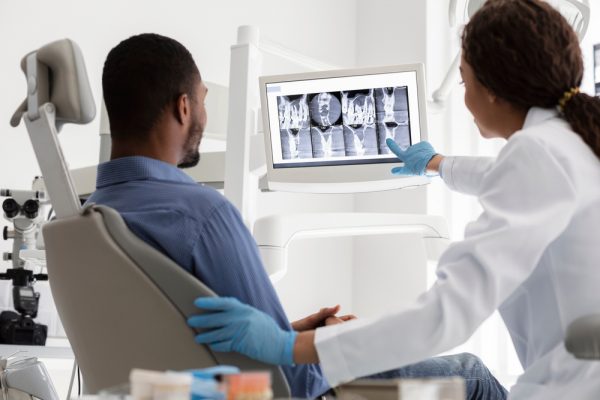3D technology in dentistry refers to the use of advanced imaging and computer-aided design (CAD) software to create detailed, three-dimensional models of a patient’s jaw, teeth, and surrounding oral structures. This technology allows for more precise and accurate planning of dental implant treatment, as well as the creation of custom-fit dental prosthetics. It also creates a digital smile design, which is a simulation of the final result of the implant treatment.
With 3D technology, dentists can plan implant placement, create surgical guides and use them to navigate the exact location of the implant with minimal invasiveness. Additionally, it allows for more accurate diagnosis and treatment planning for other dental procedures, such as orthodontics and restorative dentistry. 3D technology has revolutionized the field of dentistry.

Benefits of 3D Technology in Dentistry
Accuracy
One of the main ways that 3D technology improves dental implant treatment is by allowing for more accurate planning and placement of the implants. Traditional methods of implant placement involve taking impressions of the patient’s mouth and creating models used to plan implant placement. However, these models are often imprecise and can lead to inaccuracies. With 3D technology, dentists can create highly detailed digital models of the patient’s jaw and teeth, allowing for more precise planning and placement strategies.
Faster, Less Invasive Procedures
Another benefit of 3D technology in dental implant treatment is that it allows for faster and less invasive procedures. Traditional methods of implant placement often require multiple surgeries and a long healing period. With 3D technology, dentists can plan the placement of the implants and use surgical guides to ensure accuracy, resulting in fewer surgeries and a faster recovery time for patients.
Custom Creation of Dental Prosthetics
3D technology also allows for the creation of custom-fit dental prosthetics, such as crowns and bridges, that are tailored to the specific shape and size of the patient’s mouth. This results in a more comfortable fit and natural-looking restoration.
Digital Smile Designs
3D technology also helps dentists create digital smile designs, which are simulations of the final result of the implant treatment. Digital smile design provides the patient with a better understanding of the treatment outcome and helps dentists make necessary adjustments before the procedure.
Laser Dentistry Costs
The cost of laser implant surgery can vary depending on several factors, including the number of implants being placed and the specific type of laser used. In general, laser implant surgery is more expensive than traditional implant surgery. The cost can also depend on where your dentist is located and the cost of living in that area. Some dental insurance plans cover laser implant surgery, but coverage will vary depending on the specific plan and the type of treatment.
Please note that cost shouldn’t be the only consideration when choosing treatment. While traditional implant surgery may be less expensive, the benefits of laser implant surgery, such as reduced recovery time and improved cosmetic outcomes, may be worth the additional cost for some patients. It’s always best to discuss the cost and any other concerns you may have with your dentist before making your decision.
Also, keep in mind that some dental clinics may offer financing options for patients who need to pay for their treatment over time. Additionally, some may offer discounts or special offers for patients who pay for their treatment in full or in cash.
Frequently Asked Questions
3D technology in implant dentistry improves accuracy in several ways:
- Digital planning: By creating a detailed digital model of the patient’s jaw and teeth, dentists can plan the placement of implants with much greater accuracy, taking into account each patient’s anatomy.
- Surgical guides: Using 3D printing technology, dentists create surgical guides that help them place implants accurately and precisely. These guides are custom-made for each patient and provide a roadmap for the dentist during the procedure, reducing the risk of errors.
- Real-time adjustments: During the implant procedure, 3D technology can allow for real-time adjustments to the placement of the implants. This ensures that the implants are placed as planned, reducing the risk of complications and improving the long-term success of the procedure.
3D technology in implant dentistry helps reduce the invasiveness of dental implant procedures by allowing for more precise planning and placement of implants. By creating a detailed digital model of the patient’s jaw and teeth, dentists can plan the procedure in a way that minimizes the need for excessive cutting or reshaping. This can result in fewer post-operative complications, less discomfort, and a faster recovery time. Additionally, 3D technology can guide the actual placement of the implants, further reducing the procedure’s invasiveness.
Yes, dentists must receive additional training to use 3D technology in implant dentistry. Using CAD/CAM systems and other advanced technologies requires specialized knowledge and skills, so dentists must undergo continuing education and training to stay up-to-date with the latest advancements in this field.
3D technology in dental implant procedures has been shown to increase the success rate. By creating a digital model of the patient’s jaw and teeth, dentists can more accurately plan the placement of implants and identify potential problems before the procedure begins. This can result in a lower risk of complications and improved long-term success of the implants.
Advanced Technology Creates Higher-Quality Results
When it comes to dental implants, advanced technology has improved the treatment and results. With 3D technology, the implant procedure is more accurate, quicker, and safer. To learn more about advanced dental technology and its effects on dental implants, contact our Farmington dentists.
